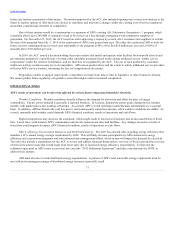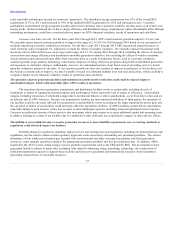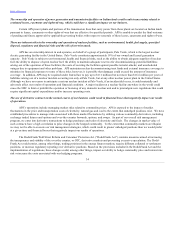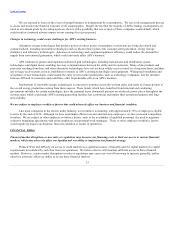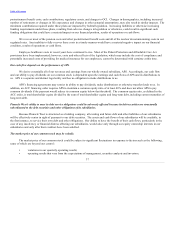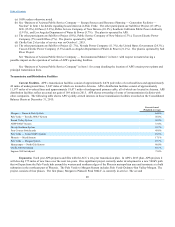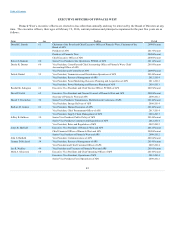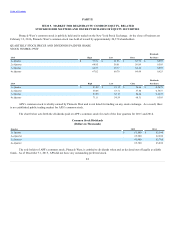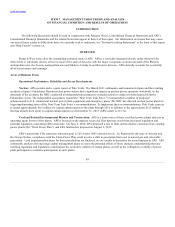APS 2015 Annual Report Download - page 44
Download and view the complete annual report
Please find page 44 of the 2015 APS annual report below. You can navigate through the pages in the report by either clicking on the pages listed below, or by using the keyword search tool below to find specific information within the annual report.
Table of Contents
and third phases, Delaney to Palo Verde 500kV and Delaney to Sun Valley 500kV, are under construction and are expected to be
energized by May 2016. The fourth phase, Morgan to Sun Valley 500kV, has been permitted and is in final design and development.
In total, the projects consist of over 100 miles of new 500kV lines, with many of those miles constructed with the capability to string a
230kV line as a second circuit.
APS continues to work with regulators to identify transmission projects necessary to support renewable energy facilities. Two
such projects, which are included in APS’s 2015 transmission plan, are the Delaney to Palo Verde line and the North Gila to
Hassayampa line, both of which are intended to support the transmission of renewable energy to Phoenix and California. The North
Gila to Hassayampa line went into service in May 2015.
Physical Security Standards. On July 14, 2015, FERC approved version 2 of the proposed Physical Security Reliability
Standard CIP-014 (CIP-014-2). As a result, CIP-014-2, the Physical Security Reliability Standard that requires transmission owners and
operators to protect those critical transmission stations and substations and their associated primary control centers that, if rendered
inoperable or damaged as a result of a physical attack, could result in widespread instability, uncontrolled separation or cascading
within an interconnection, became effective on October 2, 2015, triggering a series of staggered, but interdependent obligations for
APS. As required by the Physical Security Reliability Standard, APS determined its critical transmission stations and substations and
associated primary control centers that will be required to comply with the standard by October 2, 2015. However, as contemplated
under CIP-014-2, this verification has triggered additional requirements and obligations within the Physical Security Reliability Standard
that are not yet due to be completed. These remaining obligations, which consist of a risk evaluation and development and verification
of a physical security plan, are due to be completed by the end the third quarter of 2016. Until APS has completed all required
activities under the Physical Security Reliability Standard, we cannot predict the extent of any financial or operational impacts on APS.
NERC Critical Infrastructure Protection Requirements. In 2014, APS initiated a comprehensive project to ensure compliance
with Version 5 of NERC's Critical Infrastructure Protection Requirements (CIP V.5) which will become effective April 1, 2016. APS will
be incurring incremental capital expenditures through 2017 associated with the CIP V.5 compliance implementation project estimated to
be approximately $52 million.
Plant and Transmission Line Leases and Rights-of-Way on Indian Lands
The Navajo Plant and Four Corners are located on land held under leases from the Navajo Nation and also under rights-of-way
from the federal government. The right-of-way and lease for the Navajo Plant expire in 2019 and the right-of-way and lease for Four
Corners were scheduled to expire in 2016. In March, 2011, the Navajo Nation Council signed a resolution approving a 25-year
extension to the existing Four Corners lease term and providing Navajo Nation consent to renewal of the related rights-of-way. The
effectiveness of the lease amendment also required the approval of the DOI, as did the related federal rights-of-way grant. A federal
environmental review was undertaken as part of the DOI review process, and culminated in the issuance by DOI of a record of decision
on July 17, 2015. The record of decision provides the authority for the Bureau of Indian Affairs to sign the lease amendments and
rights-of-way renewals, which occurred in late July 2015.
Certain portions of the transmission lines that carry power from several of our power plants are located on Indian lands pursuant
to rights-of-way that are effective for specified periods. Some of these rights-of-way have expired and our renewal applications have
not yet been acted upon by the appropriate Indian tribes or federal agencies. Other rights expire at various times in the future and
renewal action by the applicable tribe or federal agencies will be required at that time. In recent negotiations, certain of the affected
Indian tribes have
41


